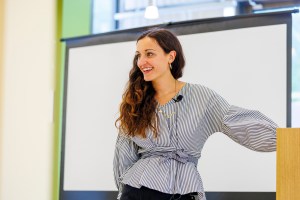
A podcast where the life of the mind meets everyday life. Join Harvard Gazette writer Samantha Laine Perfas as she convenes experts from different disciplines for conversations about issues that affect people in real, tangible ways. Produced by Harvard University. Find us on Apple Podcasts, Spotify, and YouTube.
Featured Episode
In this episode of the “Harvard Thinking” podcast, experts discuss the growing movement to restrict cellphones in schools.
Transcript
Laurie Santos: Often we get so focused on the education that happens within the classroom that we’re forgetting about the incredible education that happens in schools, in the hallways, at the dining room table, on the playground, and so on. And I really worry that might be the spot where we’re losing the most educational opportunity for having these devices around us.
Samantha Laine Perfas: There’s a growing movement to ban cellphones in schools. And some states, like Florida, Indiana, California, and Minnesota, have passed or introduced legislation restricting cellphone use in the classroom. Both parents and students have pushed back, citing safety concerns or not being able to reach each other during the day. Yet schools say the removal of phones eliminates distractions and fosters face-to-face interactions that students themselves have come to appreciate.
So, what would it look like to take phones out of classrooms?
Welcome to Harvard Thinking, a podcast where the life of the mind meets everyday life. Today we’re joined by:
Joy McGrath: Joy McGrath. I am the head of school at St. Andrew’s School in Middletown, Delaware.
Laine Perfas: St. Andrew’s is a boarding school serving Grades 9 through 12 and has had a longstanding ban on students’ cellphones on their campus. Prior to becoming head of school, Joy worked at Yale University as chief of staff to Yale’s president. She graduated from Harvard College in 1996. Then:
Santos: Laurie Santos. I’m a professor of psychology at Yale University and host of “The Happiness Lab” podcast.
Laine Perfas: She received her doctorate in psychology at Harvard and has written extensively about the link between technology and our well-being. And finally:
Susan Linn: Susan Linn. I’m the author of “Who’s Raising the Kids? Big Tech, Big Business, and the Lives of Children.”
Laine Perfas: She’s also a psychologist, a research associate at Boston Children’s Hospital, and a lecturer on psychiatry at Harvard Medical School.
And I’m Samantha Laine Perfas, your host and a writer for The Harvard Gazette. In this episode, we’ll discuss efforts to ban students’ cellphones in schools.
Why is this happening right now?
Linn: I think that we have been living with this incredibly seductive technology for several years and that what is finally coming to light is that constant exposure to social media and games and other tech products is actually phenomenally distracting and harmful. The research tells us that 97 percent of students have a phone and, according to the National Education Association, 83 percent of teachers think that we should ban cellphones.
Santos: Yeah, and I agree with Susan completely on this. Common Sense Media, which is this organization that looks a lot at kids’ use of tech, finds that over 50 percent of tweens and almost 70 percent of teens say that their phones distract them from schoolwork during the school day. They’ve also done some work showing that, on average, teens get over 200 notifications a day, a quarter of which happen during the school day, right? I mean, when you think about that kind of level of distraction, that’s just unheard of in the human species. But I think there’s another piece of it too, which is that there’s growing worries that technology and social media in particular might have some real costs for teen mental health. It’s important to be balanced about this, right? Technology has both benefits and costs when it comes to teen mental health, but overall, folks like the Surgeon General Vivek Murthy, another Harvard grad, have been talking really carefully about the fact that there’s a profound risk of harm that comes with some of these technologies. And so just finding ways to get that harm out of teen hands during the school day might be another way that we can protect teen mental health. And then I’m curious what Joy has to say about this, but I think there’s also just an educator piece where it’s a pain in the butt for teachers to have to enforce this kind of thing. I think there’s lots of dramas and headaches from phone misuse in classrooms. So it becomes another sort of enforcement issue on top of the things that teachers have to deal with all the time, just something else they have to worry about and police.
McGrath: One of the things maybe we can unpack later in the conversation is this word “ban” that we’re using, because I think ban may conjure different notions in different people’s heads. But certainly it is true that sensible guidelines and significant guardrails are needed to protect the development of children: their psychological development, their social development, their intellectual development, all of those things. Social media and the smartphones that carry social media are all about distraction and time; and the time in particularly my school, is Grades 9 through 12, so I’ll talk about adolescence. That time is so incredibly precious and, Laurie is really the expert in this, but what is happening in the human brain in that age group is incredibly important. And that time is still childhood. When families come to look at our school, which people are opting in here to our program, including our cellphone restrictions, and in many cases we find they’re looking for it; they’re shopping for that, including people who work in the tech industry and in Silicon Valley who want to get the social media and the phones out of their children’s hands. And I think it’s partly what Laurie was just alluding to, that it is very hard for teachers to put these guardrails in place unilaterally. It is also very hard for families to put them in place unilaterally because the devices are connecting children to children. And so if you’re the only family at the school or in the classroom or on the block that is putting sensible restrictions in place for your child, that can be a very difficult row to hoe for a parent.
Linn: I just want to point out that it’s not just teenagers who use phones all the time. Ever-younger children are getting smartphones and bringing them to school. I think that’s really important.
Laine Perfas: Actually, I had a situation this past weekend. I have a son who’s about to be 3, and there was a little girl and she kept asking me all these questions, and then out of nowhere, she went, “I’m 5. I have a cellphone. Does he have a cellphone?” And I was like, “No.” And she was like, “Oh, when are you going to give him one?” And I was like, “When he’s 20.” And the look on her face! She was appalled and really questioning my parenting skills, but I was actually quite surprised that a 5-year-old would be having their own cellphone. So it is, I think it’s a good point that it is getting younger and younger.
Santos: And I think that’s something that comes up as we think about bans or maybe a less strict word of restrictions. We need to think about what’s developmentally appropriate, right? The kind of ban or kind of restrictions we might put on a senior year high school classroom is going to look totally different than the ban that we might put in preschool or kindergarten, in the case that you’re talking about. And so I think it’s really important to understand psychologically what’s developmentally appropriate.
Laine Perfas: Yeah, Joy brought up a good point about unpacking the word ban. What do we mean when we talk about bans?
Santos: I think there are different ways to talk about it, right? There’s a kind of full ban: Never bring these things into the building. There might be a situation where during some points in the school day, phones are secured. That’s tricky because it often involves schools that require the resources to hold everybody’s phone securely and to have someone there to distribute phones back during the periods of time when students need them and things. But they’re also just specific-use kind of restrictions that teachers and administrators might put in classrooms. For example, no social media use during the classroom, but you’re able to use your devices to go on, for example, Wikipedia, or to use a tech-focused app that we’re using in the classroom. And so I think when we think of banning phones, often we don’t mean these things can never come into the building and they’re gone for all age groups and so on. Often what we’re talking about is, what’s an educationally appropriate restricted use that we can have?
McGrath: For us, we’re a boarding school at St. Andrew’s, so our students are here around the clock. So we have to think about it the way parents might think about it. Our 12th-graders are permitted, if they wish, to have their phones in their rooms overnight because they’re going to be going to college and they need to learn to regulate that. Our values, as you say, are, first of all, that education is to foster independence. If we’re going to have those developmental opportunities for independence, we have to have those opportunities to play, to form good social relationships, to interact in person, to study, to sleep, to do those things.
And then we’ve been thinking a lot about what happens when kids leave our school. Because when I visit our alumni who are freshmen in college, and I’ll often say, “What in college were you least prepared for?” And probably the most frequent answer I get now about what they miss most about St. Andrew’s is the other students in college form friendships and socialize with their phones in their hands. Essentially our students are forming friendships in a manner of what now seems like ancient history and that pre-device time, because we don’t have our phones around the schools.
Linn: I think that limiting certain things that kids can do on their phones while allowing them to have their phones in class — I think that’s problematic. Once you get on your phone, it’s really hard not to do other things. When I got my smartphone, I stopped wearing a watch. And then I realized that every time I’ve checked the time, I also checked my email, and I checked my texts and, things like that. So, I think that it’s really best for the students and the teachers and their education and their mental health to make sure that phones are not part of the active school day. Yes, technology is certainly part of our lives, but part of being able to live with it and to live a productive, healthy life is to be able to know when to use it and when not to use it. And so I’m wondering, if your students, when they tell you this, are they telling you this because they’re distressed that they didn’t have phones during the school day? Or no, it sounds to me like it’s something they’re looking back on and they’re really thankful.
McGrath: They’re thankful for it and they’re innovating solutions in their college context that are making that situation better. So one student, a young woman, told me that she took an Amazon box very early in her time in college, decorated it, put it in a room, and when kids come in a room to hang out, all the cellphones go in it and they put them under the bed for that hangout time. Everybody’s happier and she feels really good about that. My hope, of course, as an educator, is that students who’ve had those experiences are able to go on to their next context and maybe share some of these tactics or skills that help other people as well put their phones down and have some meaningful connection.
If you think about your cafeteria or your dining hall, that is a really important place to preserve that for kids, that human interaction time around meals; that is an ancient human way of forming relationships and overcoming the boundaries we may draw between ourselves and what today we would call polarization in society. And so I think we think about classrooms as a knee-jerk for a quote-unquote ban, but I always advocate for if you’re going to do it in one place, think about that dining hall or that cafeteria.
Santos: Yeah, Joy, I love that you’ve brought that up because this is something I’ve seen as a psychologist, right? There’s a growing amount of work just showing how little we socially interact just when our devices are around us. The psychologist Liz Dunn, incidentally, also a Harvard undergrad graduate, she’s a professor at UBC now, and she’s done some lovely work just looking at what are the kind of social costs to having your phone around you, even if you’re not looking at it, right? It’s just out on the desk or it’s out on a dining hall table, and what she finds is that people smile at one another 30 percent less when their phones are around. Because part of your brain is, and part of your attention is, getting picked up by this phone.
But your comment about the dining hall resonated for me in a different way. For a long time, I was a head of college on campus, what Harvard used to call master and is now called faculty deans, this is a position of a faculty member who lived at Yale in the colleges, but at Harvard in the Houses with students. And so, I would eat with them in the dining hall and one of the things I was expecting when I first became a head of college was for the dining hall to be, you know, the loudest place on the planet with everybody talking to one another and so on. And it’s different than when I went to Harvard back in the ’90s; right now you have a lot of students with these big Bose headphones on and they’re looking at a screen and they’re just not interacting with one another. This opportunity cost of face-to-face in-real-life social connection with, you know, the smartest people around you, including people whose identities might differ and might have different political opinions than you and so on. But I think we’re not paying attention to what’s lost. I love your comment, Joy, because often we get so focused on the education that happens within the classroom that we’re forgetting about the incredible education that happens in schools, in the hallways, at the dining room table, on the playground, and so on. And I really worry that might be the spot where we’re losing the most educational opportunity for having these devices around us.
Laine Perfas: I really appreciate that because as I mentioned earlier, when you hear the idea of a ban or a restriction, it feels like something’s being taken away. But if we look at it as an opportunity to protect students during such a pivotal time in their development, it provides a totally different way of looking at it and I think that can be really helpful as we go through this transition as a country. I also mentioned earlier, there’s a growing number of states, cities, districts that have enacted or introduced policies that restrict phone use in some way. I am wondering how that’s been going and, in the places where it’s not been going particularly well, what’s happening there.
Santos: My understanding of when it doesn’t go well is when a policy is just rolled out without explanation, without community buy-in, whether that’s from parents or the students themselves or teachers. I think the best way to do this would be at a school-by-school level and to really involve everybody and having a conversation about your community norms when it comes to digital tech use. You know, as you said, these things aren’t going away. We all see the benefits of these as well as the drawbacks. That’s true for our students, too. I think one of the things that’s striking is pretty much every survey that’s been done with teens or even tweens, they find that they see the benefits of technology, of course, but they also see a lot of the drawbacks, right? And I think for the most part, they want some help about how to navigate these sorts of decisions. And so I think, the more stakeholders we can bring to the table to have this honest conversation about, how can we as a community co-create these norms, right? And in fact, how can we co-create norms that the adults in the school will have to follow too? Even in the Yale classroom in my “Science of Happiness” class I talk a lot about the problems of social media and being on technology and distraction and I’d occasionally see students in my courtyard who’d be like, “Dr. Santos, like, you’re on your phone now. I thought you told me it’s distracting,” right? And so I think finding norms that the adults can say, “Hey, I agreed to these too. I’m committed to modeling these kinds of norms and values for my students or for my own kids in my own home” — I think those kinds of co-created values wind up being much more powerful than what seems like somebody from on high kind of coming up with this decision.
Linn: The Phone-Free School Movement, that organization has created just a fabulous tool kit for school administrators to help them create policies around phones that really benefit students and not tech companies. And I think one of the things that we’re facing is that the tech industry has huge amounts of money and does huge amounts of lobbying. We’re facing this enormous industry whose interest in teenagers and children is not to promote their well-being, but to promote the company’s own profits. And so I think that’s why, if this is difficult, that’s a huge reason.
McGrath: I just wanted to pick up on something Susan said and then something Laurie said and tie them together, because it is true that apps and social media are targeting young people and that they have a lot of power and a lot of money. But the reason that they’re targeting young people is the same reason that advertisers have targeted young people forever, which is young people have an incredible amount of power. And everybody who works with young people believes that and knows that is true. And Laurie was talking about how important developing shared community norms would be in a process of instituting sensible restrictions on phones in a school setting, and I will say I’m the beneficiary at St. Andrew’s of a school where we did not impose these restrictions. My predecessor was very slow to put Wi-Fi in our dorms. Students started out with flip phones and they weren’t very interesting so they didn’t carry them around the school, so what happened was there was a rule that flip phones should stay in the rooms. And then, just the rule never changed. But the rule never changed because of a really slow-moving process of discussion among the students of continuing to embrace this policy. So we have what I would say is a student-led phone culture. It’s really led by the kids and every year our seniors who do a lot of leadership in the school rearticulate to the younger students, whom they lead and they supervise in the dorms, why this matters and why this is so important at St. Andrew’s.
Santos: I agree completely and I think one of the ways that we educate students is to actually tell them about the kinds of things that Susan was talking about, right? There was a lot of really early work on persuasion that took place in the cigarette industry. Back in the ’70s and ’80s, you know, lots of kids smoked and there was a question of, how could we get teens to realize the danger of this? Some of the most effective educational campaigns actually told teens about what cigarette industries were doing. They basically said, “Hey, they put these chemicals in there to try to hook you and they want to get you early. This is their plan,” right? And I think the same kind of educational approach can be incredibly powerful with social media; when kids start to learn how these algorithms hook them in and how people are making money off their privacy and their identities and their preferences; just like adults, teens tend to get a little pissed about that, right? And so I think part of our digital citizenship education can be a deep dive into how these algorithms work, how companies are hooking your reward structures, how other people are trying to control you in these ways.
Laine Perfas: It makes me wonder in what ways students can be part of the solution and why they should be. I’m seeing a lot out there about regulations being created, but I’m not seeing as much about how students have been involved or not involved in creating those regulations.
Santos: As we think about best practices, I think it’s really important to make sure that whole communities are involved, but especially the students are involved, for a couple reasons. One is that survey after survey show that they care a lot about what these norms are. They’re worried, and they want some guardrails on the kind of technology use they have in all kinds of settings. And so I think getting them involved in the conversation is really important. But that’s also critical because the students themselves are the ones who know how they’re using these technologies, right? Like, they know which apps are active. They often know a lot of the threats that people are facing because they’ve seen some of the sort of digital drama and bullying and these things happening. And so I think whenever possible, getting students to the table to think about what these best practices are winds up being really critical. It’s also a fabulous way to get student buy-in. Because if you’re going to roll out a new policy, you definitely want it to be one that students feel like they had some say in and that they’re actively excited about. This is the technique that I’ve used in some of my own work, not just with cellphones at the college level, but also other new technologies that everyone’s worried about. I was teaching my seminar recently when Chat GPT emerged and I had to have a conversation with our students to ask, “Hey, what do we think our communal values are when it comes to using this technology? What’s an appropriate use case? What would you feel like was maybe inappropriate or made things unfair in terms of your participation in this class?” And we had a fabulous discussion where we co-created some norms about what was going on. That was so much more effective than if I just came down and say, “Hey, you can’t use this AI tool in this way,” right? Students would get around that.
Laine Perfas: One of the things I want to talk about is some of the pushback. And the tech industry makes sense. They’re looking out for their bottom line. I don’t think it’s a surprise to anyone that they’re pushing back against some of these regulations. But one group that’s been surprising and was one of the reasons we wanted to talk about this in this podcast is actually parents have been pushing back a lot against these bans to the point where they’re actually a major player in some states and schools deciding not to institute restrictions. What is happening there? If we know that phones are so damaging and we know that social media is damaging, why are parents so resistant?
Linn: I think that’s part of a larger issue around being a parent today. And parents are marketed fear a lot. Fear is profitable. And parents are more fearful for their kids. They’re more anxious about them. They’re more worried about their safety. It’s like the person whose hypochondria was complicated by illness. Parents’ fears are complicated by school shootings, and it’s not like there are huge numbers of school shootings, but they’re in the media so much. And stranger kidnapping hasn’t changed in 25-30 years, but parents are more worried about it today. So the message is, “We live in a dangerous world, I have to be able to contact my child at all times.” And so I think that’s part of a larger concern and worry about parent-child relationships today. But my understanding is that one of the things that parents say, “I want to be able to contact my child if there’s an emergency.” But what the school security people are saying is that actually cellphones can contribute to the problem if there’s some kind of emergency and that really kids are safer without them in that situation.
Santos: I think, again, it’s helpful for parents if we get away from a focus on a ban completely and more, how can we more safely use these devices, which we know have benefits, but in a way that causes the least harm? And I know I mentioned Vivek Murthy before, the surgeon general, but he has this lovely analogy that I find quite powerful and also quite optimistic. He talks about how back in the ’60s and early ’70s, there were a lot of child deaths in cars, and folks kind of had the same responses we have for social media like, well, you know, it’s really dangerous and it caused all this harm. But we need our cars. What are we going to do? And Vivek said, no, what we decided was we needed seat belt laws, right? We needed to put in car seats for really young children. We put in the regulation to engage with this new technology we had, driving around in a way that was a little bit safer, in a way that protected kids. And I think this might be the best way to think about what we want to do with cellphones, is not necessarily to ban them completely, but to make sure we restrict them in the moments where they’re harming kids; when they’re harming kids’ education in the classroom, when they might be harming kids’ social interactions, on the playgrounds, and the dining halls, and so on. We might want to put boundary conditions, for example, on how much usage that we allow kids to have. Governments can publish best practices about what we should do.
Linn: The other thing is that for schools implementing safety regulations around phone use, I think that it’s going to be hard in the beginning, and then it’s going to get easier because for the parents coming into the school it will already be a school rule, so they’ll know. What’s going to be hard is for the students and the parents and the teachers and the administrators who are there now. That’s when it’s going to be difficult and then I think it’ll just be part of what schools do and schools have all sorts of rules about what kids can and can’t do. I think that ultimately this will just be another one of those, but it’s going to be bumpy in the beginning.
McGrath: The other thing that I always think about is parenting is this terrible conundrum. You’re given this little being who is the most precious thing in your life, and your job is to keep it safe and yet make sure that it doesn’t need you someday. So there’s this real cognitive dissonance in parenting. I’ve, as a head of a boarding school, the meeting I have on drop-off day with all the new parents who are leaving their kids at school for the first time and driving away until family weekend, six weeks later, and I have to say, all of our experience shows it would be really great if you don’t make a lot of contact in the first two weeks. My predecessors said that 40 or 50 years ago to parents when they were leaving the school because it was just still true. There’s just this incredible tool we have to be in constant touch with our kids. And so it is a conundrum, and I think we need to continually break down this notion that the phones are part of some kind of safety program for children. They are not. We haven’t mentioned Jon Haidt’s book that came out last spring, “The Anxious Generation,” but that’s certainly one of the reasons why this debate about phones in schools is kicking off again. And we can see in the data presented in that book all of the possible risks to health and safety and even life of young people in some cases. And so I think I constantly want to both acknowledge that conundrum that’s very real for parents as they’re preparing their children for independence, but of course we know it’s so important for young people, if they can, to have really healthy relationships with their families and have those familial connections.
And so, how do we balance that? And that is just, it’s a matter of practice and having common-sense restrictions in place, but also, when a child really has a need to be in touch with their parent, making that happen also, right? And I think it’s important to reassure parents that if they need to change their pickup time or if something happens that there is a way to do it and schools need to implement that way. So parents can get messages to kids through the office or through some central location or something. So it’s not interfering with what’s going on in the classroom or the playground or the cafeteria.
Laine Perfas: One of the things that I think can really ground this debate/conversation is remembering that the goal of some of these restrictions is to help students to connect with themselves, connect with each other, their teachers while they’re at school, and maybe lay a foundation for them into their futures. So knowing that, what questions should everyone involved in this conversation be asking themselves to figure out the policies that would be beneficial for them to adopt?
Santos: I think an important one is really just to ask how digital technologies, phones, but digital technologies broadly, fit into a school’s values. How they connect with learning, how they connect with social connection broadly, how they connect with safety. These are the kinds of important questions that I think all schools should be asking and I think, how can we train our students for the digital world that they face?
Linn: One of the things that’s really, I think, confusing for parents is that starting when kids are babies, parents are marketed all these devices and all these screen products that are claiming to be educational and beneficial to young children, when there’s no research showing that they are beneficial or helpful. I’ve had conversations with parents who say, “My child has to use an iPad because otherwise my child’s not going to be able to get a job if he doesn’t have or she doesn’t have tech skills.” What people aren’t being told is that the technology is going to change so much that giving a young person an iPad is not going to help them get a job. What’s going to help them is what they learn through interacting with other people and engaging with the world around them. That’s what’s really going to be beneficial.
McGrath: Yeah, and I think the questions to ask really are the basic ones. In the United States, educators have always talked about what is the best education to raise citizens for our democracy in the future. I think that’s still one of the questions, right? How are we going to put together an educational program in our school that best supports the development of students in every way; their social development, their intellectual development, their physical development, and how are we going to create the time to do that? How are we going to build an education that fosters independence and in students the ability to think for themselves?
Laine Perfas: Thank you for joining me for this really awesome conversation.
Santos: Thanks so much for having us on the show.
McGrath: Thanks for having us. It’s been really fun.
Linn: It’s my pleasure.
Laine Perfas: Thanks for listening. This episode was hosted and produced by me, Samantha Laine Perfas. It was edited by Ryan Mulcahy, Simona Covel, and Paul Makishima, with additional editing and production support from Sarah Lamodi. Original music and sound design by Noel Flatt. Produced by Harvard University. Copyright 2024.
More episodes
-

How far has COVID set back students?
An economist, a policy expert, and a teacher explain why learning losses are worse than many parents realize
-

Forgiving what you can’t forget
Wronged and can’t move on? A theologian, a psychologist, and a public health expert discuss why and how to heal.
-

Is AI friend or foe? Wrong question.
A lawyer, a computer scientist, and a statistician debate ethics of artificial intelligence
-

Facing death with dignity
A chaplain, a bioethicist, and a doctor talk about end-of-life care
-

Climate alignment is no easy task
Experts at the Salata Institute outline tensions between global and local priorities
-

Our democracy problem
‘Harvard Thinking’ asks three scholars how a ‘big, heterogeneous, diverse country’ can avoid coming apart
-

What do we do with our loneliness?
‘Harvard Thinking’ looks at health crisis with experts Jeremy Nobel and Milena Batanova
-

How much drinking is too much?
‘Harvard Thinking’ explores the health effects of moderate alcohol consumption
-

Harvard Thinking: Where the life of the mind meets everyday life
A new podcast with an interdisciplinary focus on today’s big issues
